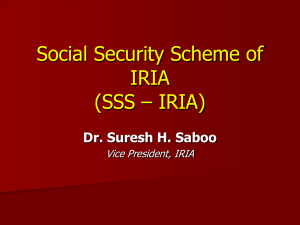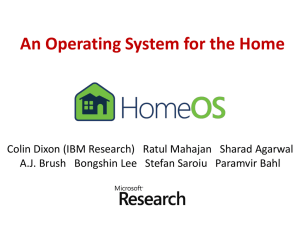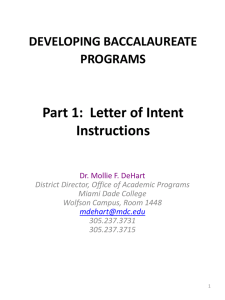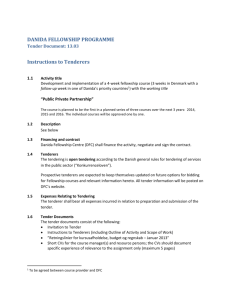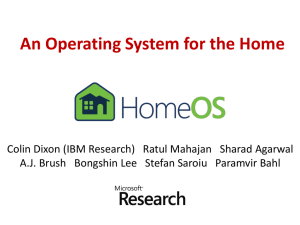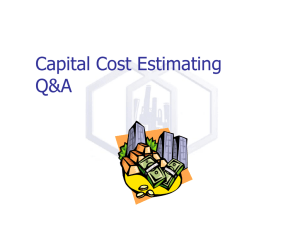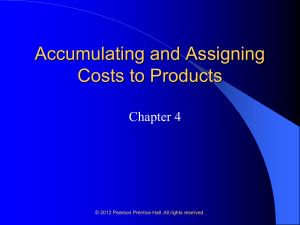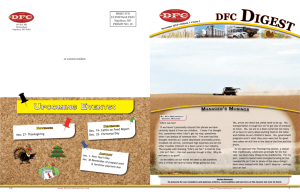05(lecture 7 - CapCost Q and A)
advertisement
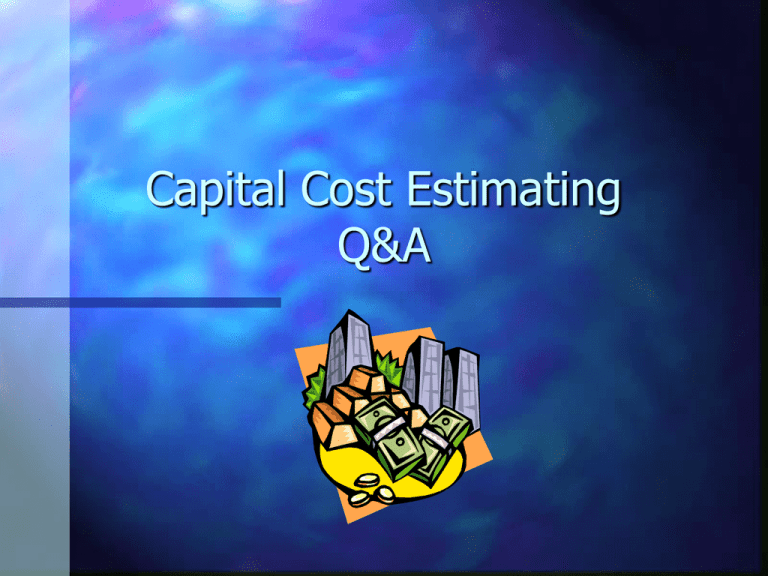
Capital Cost Estimating Q&A Note to Reader This presentation was prepared for the purposes of answering e-mail questions from the prior year. This years version may look substantially different. Question 1 “What exactly is a ‘factored equipment estimate’ ?“ What’s a “base cost”, “bare module cost” and what’s included in the latter? What factors are applied to get a total estimate of the plant? What do these factors take into account? •Equipment Cost •bulk materials & labour Tanks and (DFL) Vessels Direct Field Labour Equipment Factor Equipment Purchase Price Equipment Factor “Off Sites” Cost Direct Field Labour (DFL) Direct Field Cost (DFC) 0.25 x DFC 1.0 to 1.6 x DFL Indirect Field Cost (IFC) Home Office Engineering Allowances Total Project Cost (ITC) to install Direct Field Cost (DFC) 0.25 x DFC Columns and racks, Trays rail spurs …) •off-sites (pipe TOTAL Pumps and PROJECT x Factors •INDIRECT FIELDCompressors COSTS Indirect Field Cost (IFC) COST 1.0 to 1.6 x DFL Exchangers •engineering, freight, insurance, overhead Heaters •CONTINGENCY AND FEES • Home Office Engineering •firstOff fill of plant, Plus Sites , ietaxes, duties Piperacks,Rail AllowancesSpurs, •escalation Tank Farms etc Direct Field Total Project Cost (ITC) Cost 0.25 x DFC Equipment Purchase Estimate From Equipment Price Price •DIRECT FIELD to COSTS DFC “Off Sites” Cost Estimate •DIRECT FIELD COSTS •Equipment Cost •bulk materials (piping, valves, instruments) & labour to install •off-sites (pipe racks, rail spurs …) •INDIRECT FIELD COSTS •engineering, freight, insurance, overhead, const supervision •CONTINGENCY AND FEES •first fill of plant, taxes, duties •escalation TOTAL PROJECT (CAPITAL) COST Method 1: Lang Factored Estimate Total Capital Cost = Flang * (Sum Of Purchased Cost of Equipment) Flang = 4.74 for fluid processing plant Method 2: Equipment Cost Factor Equipment Purchase Price “Off Sites” Cost Direct Field Labour (DFL) 0.25 x DFC 1.0 to 1.6 x DFL X Equipment Factor Direct Field Cost (DFC) Indirect Field Cost (IFC) Home Office Engineering Allowances 1.18 x Total Project Cost (ITC) “Off Sites” Cost Direct Field Labour (DFL) 0.25 x DFC 1.0 to 1.6 x DFL X Equipment Factor Direct Field Cost (DFC) Indirect Field Cost (IFC) Home Office Engineering • Tanks and Vessels Columns and Trays Pumps and Compressors Exchangers Heaters Plus Off Sites, ie Piperacks,Rail Spurs, Tank Farms etc Allowances 1.18 x Total Project Cost (ITC) x Factors Direct Field Cost 0.25 x DFC From Equipment Price to “Direct Field Cost” Equipment Purchase Price Rail Car Loading “Off Sites” Cost Direct Field Labour (DFL) 0.25 x DFC 1.0 to 1.6 x DFL Cooling Tower X Equipment Factor Direct Field Cost (DFC) Indirect Field Cost (IFC) Home Office Engineering Allowances 1.18 x Total Project Cost (ITC) Rail Spurs Fire Water Sys Steam Boilers Pipe Racks Inside Battery Limits Nitrogen Plant Office Bldg 0.25 x DFC “Off Sites” Equipment Purchase Price Equipment Purchase Price “Off Sites” Cost 0.25 x DFC 1.0 to 1.6 x DFL Indirect Field Cost (IFC) Home Office Engineering Allowances 1.18 x EQUIPMENT FACTOR PURCHASE COST Direct Field Cost (DFC) MODULE COST Total Project Cost (ITC) 0.25 x DFC Equipment Factor Direct Field Labour (DFL) X Equipment Factor Equipment Purchase Price “Off Sites” Cost Equipment Factors 1.0 to 1.6 x DFL Shop Fab. Vessels Compressors Exchangers Fired Heaters Pumps Material Handling Equipment Direct Field Cost (DFC) Indirect Field Cost (IFC) Home Office Engineering Allowances 0.25 x DFC 2.0 - 2.5 1.5 - 2.5 1.7 - 2.5 1.7 - 2.5 2.5 - 3.5 1.5 - 3.0 1.18 x Total Project Cost (ITC) 0.25 x DFC Direct Field Labour (DFL) X Equipment Factor Equipment Purchase Price “Off Sites” Cost Direct Field Labour (DFL) 0.25 x DFC 1.0 to 1.6 x DFL X Equipment Factor Direct Field Cost (DFC) Indirect Field Cost (IFC) Home Office Engineering Allowances 1.18 x Total Project Cost (ITC) Method 3: The CAPCOST Approach Equipment Parameters (Pressure, MOC, Size, Hp …) “Base Cost” = Purchase Cost of Equipment - in Carbon Steel and 0 barg Bare Module Factor = f (Factorpressure, Factormaterial) BARE MODULE COST (Directs and Indirects) Which One Do We Want? - installed equipment in actual materials and actual pressure Module Factor = 1.18 MODULE COST OF PLANT - for expansion to an existing Plant -contingency 15%, fees 3% Grass Roots Factor = 1.30 GRASS ROOTS COST OF PLANT - infrastruction (utilities, off-sites aux. Buildings, product storage, loading and unloading facilities ...) CHEE 470 Stops Here Determine Equipment Cost Note: Price for Carbon Steel Construction and 0 Bar(g) Fixed Tube exch with 28 m2 = $6500 Convert To Today’s $’s using the CEPCI value Factor to Today’s Cost $6500 * (1999 CECPI / 1996 CECPI) = today’s cost $6500 x (390.6 / 381.7) = $6650 in 1999 Pressure Factor (Fp) Pressure Factor Fp = 1.14 Material Factor (Fm) Bare Module Factor FBM Fp Fm 1.14 x 3 = 3.42 Therefore FBM = 7 Bare Module Cost = Base Cost x FBM = $6650 x 7 = $46,550 Nowhere is the purchased cost of the equipment (at design press and materials) Module Cost Of Plant Add Contingency and Fees (building permits, environmental permits etc.) Module Cost = 1.18 for all equipment) S (of Bare Module Cost Module Cost = 1.18 x $46,550 = $ 54,900 Question 2 What is a capital cost? Capital Cost What’s “Capital ?” – Capital is the money required to build a plant or facility It’s separated from “Expense” money because of the Tax implications imposed by Revenue Canada, IRS, etc. Facility Timeline Facility Creation Conceptual Engineering Expense $ Detailed Engineering & Construction Capital $ Capital Cost Facility Operation Start-up Expense $ Expense $ - Operating Expenses -Depreciation Capital vs Expense Once the plant is running ‘Expenses’ are small items or costs which are incurred yearly, or have about a 1 year life. – i.e. Software, Office supplies, wages, advertising, heat, lighting, ... When Calculating Yearly Income Subtract your Expenses From Your Income Capital vs Expense ‘Capital’ are expensive items or items which have more than a year of life. – i.e. House, lawnmower, TV, computer, chemical plant equip, first fill of chemicals Revenue Canada etc. only allow you to subtract a % of the Capital every year to account for the wearing out of the facility (depreciation). – This is called the “Capital Cost Allowance” Capital vs Expense Capital Cost Allowance ( CCA ) – Works Like a Bank Account – Revenue Canada allow a % of the remaining asset value to be claimed Remaining Asset Value Time (years) CCA Classes Taxable Income Income That’s Taxable (Net Income) Taxable Income = Income - Expenses - CCA Can’t use CCA if Expenses are greater than Income (can’t use CCA to claim a loss) CCA can be ‘banked’ for later years where profit is occurring Small Business Tax- Revenue Small Business Tax - Expenses CCA Capital - The Point Capital is only allowed to be ‘depreciated’ over years and thus it’s ability to minimize taxable income is limited. Expenses are claimed in the year they’re paid. They’re better for minimizing your taxes. The Games People play The Capital Cost Estimate The tax implications of Capital money requires that you know how much Capital was spent on any asset. The business financial analysis (NPV etc.) requires that you know the Capital Cost and the Operating Cost well ahead of actually spending any significant amounts of money. Capital Cost Estimate Summary: The cost to initially build the facility which will be depreciated over time. Question 3 -CAPCOST arrggh! “When our tube/shell design pressures are below those which CAPCOST recognizes, do we simply take the minimum CAPCOST pressure and size on that basis?” Off The Shelf Items Piping, Valves, Pumps and most equipment have been standarized in design pressures of the connecting Flange Standards are called 150, 300, 600, 900, 1500, 2500 “lb” flange ratings. – A 150lb rating 150 psig rating, temperature is important in the ultimate strength of the item – Along with standard flanges are standard pipe wall thickness (Sch 40, Sch 80 etc.) Flange Rating Max Pressure vs Temp 1600 Pressure (psig) 1400 1200 150 lb Rating 1000 300 lb Rating 800 600 lb Rating 600 300 lb 304 SS 400 600 lb 304 SS 200 0 0 500 Temp (°F) 1000 Heat Exchanger Standards TEMA - Tubular Exchanger Manufacturers Association – dictates minimum requirements for exchanger mechanical design Legislation does not require TEMA standards be used. ASME- Pressure Vessel Standards ASME Code – It started in Chicago after a major explosion in a shoe factory that had a boiler. The boiler explosion caused the government to start regulating pressure vessels (including boilers). – A tool for regulating manufacturers of pressure vessels, heating exchangers, and piping, not pumps, not compressors (no rotating equipment) ASME- Pressure Vessel Standards – Since the explosion in Chicago codes were developed for the guidance in the calculation of pressure vessels, tables of metal strength vs temp – Safety factor of 4 has historically been applied to the mechanical strength of metal, recently (this year) it was reduced to 3.5 ASME Code Sections I - Power Boilers II - Materials (properties i.e. allowable stresses) III - Nuclear Power Plants IV - Heating Boilers V - Non Destructive Examination VII - Guidelines for the Care and Operation of Heating Boilers IX - Welding and Brazing Qualifications X - Fiber-Reinforced Plastic Pressure Vessels XI - Rules for Inservice Inspection of Nuclear Power Plant Components Minimum Design and CAPCOST Allowing CAPCOST to choose a minimum makes sense since the manufacturer would do the same. Question 4 - Unknown Equipment To size the reactor cooling jacket do we send you our data? Is there significant expense in the jacket? •Jacket cost is about $35,000 for the reactor. CAPCOST - User Added Eq. Treat as an additional piece of equipment Bare Module factor is irrelevant Question 5 - Storage Tanks How do you do the costing for the cone roof storage tanks? User Added - Storage Tanks $239,000 Multiply by 2 to get “bare module cost” Adding Storage Tank Question 5 -Agitator “How can we account for the agitator (shaft, seal + motor) cost in our estimate?” Reactor Diagram Agitator Costs $65,000 Multiply by 3.0 to get “bare module cost” in CAPCOST The Final Screen

